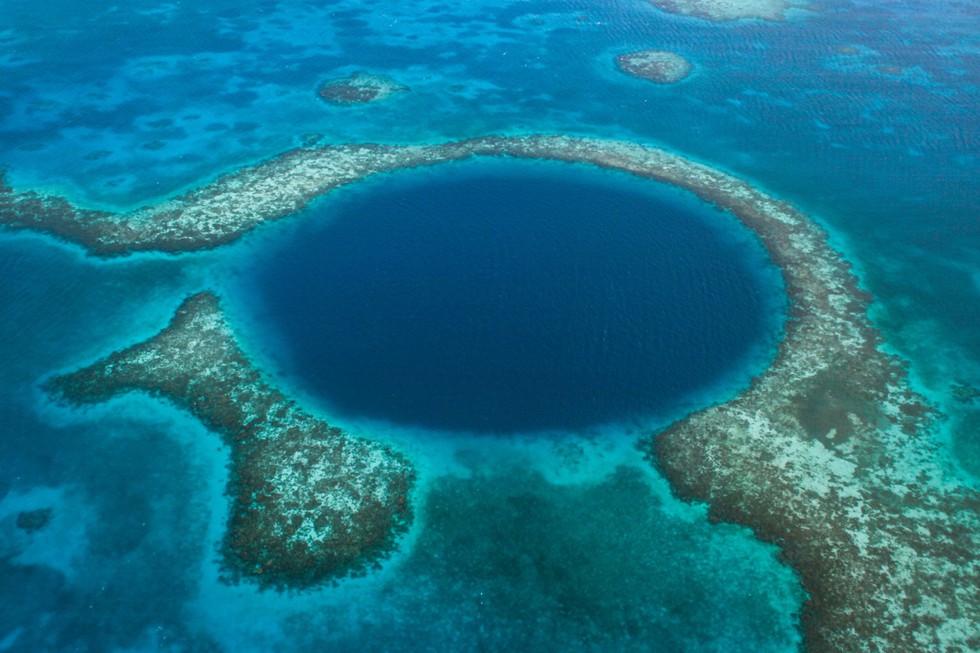Scientists recently discovered a significant geological feature off the coast of the Yucatan Peninsula in Mexico. This discovery sheds light on unique underwater environments.
Characteristics of the Taam Ja’ Blue Hole
- Location: The blue hole, named Taam Ja’, is situated in the Chetumal Bay.
- Dimensions: It spans an area of 13,660 square meters and reaches a depth of around 900 feet, making it one of the deepest blue holes globally.
- Formation: It features a circular shape with steep sides, covered by various geological formations like biofilms, sediments, limestone, and gypsum ledges.
Research and Documentation
- Scientific Study: Researchers from the Department of Observation and Study of the Land, the Atmosphere, and the Ocean in Chetumal conducted extensive research on the blue hole.
- Methods Used: They employed echo-sounding, thermohaline profiling, chemical analysis of water samples, and scuba diving for exploration and documentation.
- Publication: Their findings were published in Frontiers in Marine Science, detailing the unique characteristics of the Taam Ja’ Blue Hole.
Implications and Significance
- Evolutionary Insights: The discovery offers insights into the evolution of marine life over millennia, with potential similarities to other blue holes, such as those in the Caribbean.
- Biological Exploration: Previous discoveries of bacteria in similar environments hint at the possibility of unique life forms thriving in the depths of the Taam Ja’ Blue Hole.
Geological Features and Environmental Conditions
- Terraces: Discontinuous terraces were observed at varying depths near the walls of the blue hole.
- Structure: The blue hole exhibits a conical shape, with deeper areas predominantly located on the northern side.
- Salinity and Temperature: Significant variations in salinity and temperature were noted within the blue hole, indicating complex environmental dynamics.
- Water Source: While surface salinity reflects estuarine conditions, deeper layers indicate seawater as the primary source.
Future Research Directions
- Temporal Monitoring: Continuous monitoring of physicochemical and biological features is essential to understanding the variability and dynamics of the blue hole’s ecosystem.
- Water Exchange: Exploring water exchange between the blue hole and the surrounding Chetumal Bay estuary will provide valuable insights into biogeochemical processes.
Comparative Analysis
- Deepest Blue Hole: The Taam Ja’ Blue Hole ranks as the second deepest globally, with the deepest recorded in the South China Sea at 987 feet.
Multiple Choice Questions (MCQs):
- Where is the Taam Ja’ Blue Hole located?
- A) South China Sea
- B) Caribbean Sea
- C) Chetumal Bay, Mexico
- D) Indian Ocean
- Answer: C) Chetumal Bay, Mexico
- What distinguishes the Taam Ja’ Blue Hole from other geological features?
- A) Its circular shape
- B) Unique underwater ecosystems
- C) Presence of limestone formations
- D) All of the above
- Answer: D) All of the above
- How was the Taam Ja’ Blue Hole studied and documented?
- A) Satellite imaging
- B) Scuba diving and echo-sounding
- C) Laboratory simulations
- D) None of the above
- Answer: B) Scuba diving and echo-sounding
- What significance does the discovery of the Taam Ja’ Blue Hole hold?
- A) Insights into marine life evolution
- B) Potential for biotechnological applications
- C) Understanding geological formations
- D) A and B only
- Answer: D) A and B only
- Which oceanic feature holds the record for the deepest blue hole?
- A) Atlantic Ocean
- B) Mediterranean Sea
- C) South China Sea
- D) Arctic Ocean
- Answer: C) South China Sea
